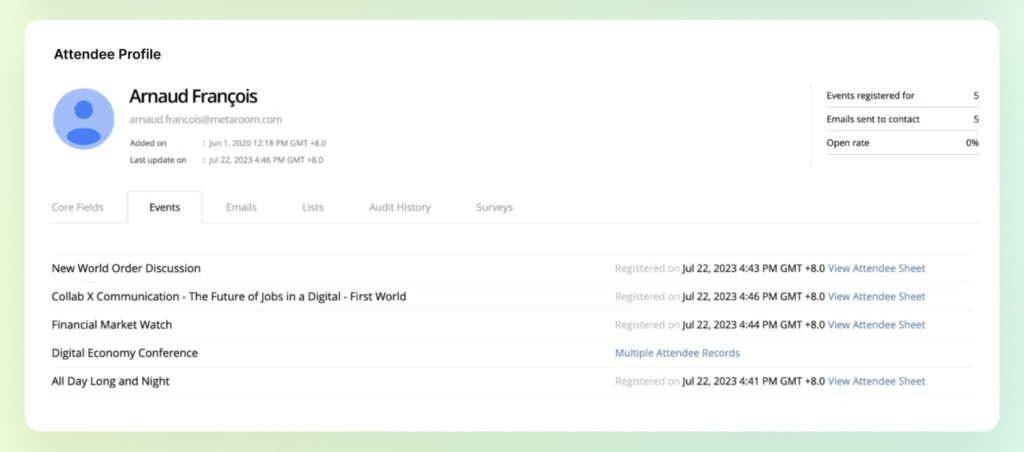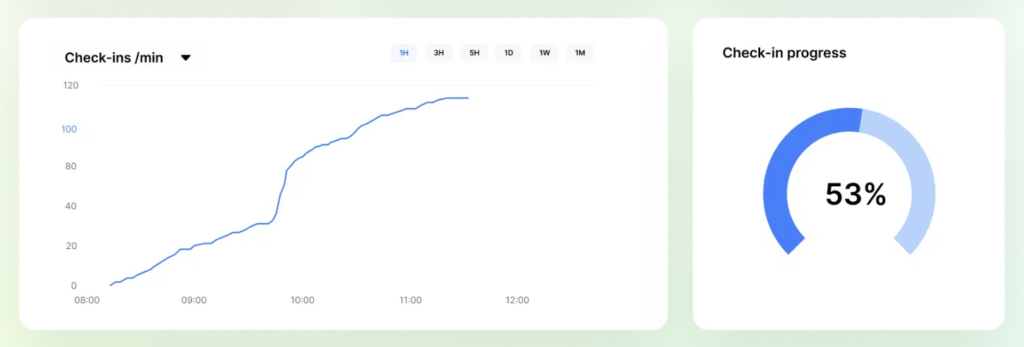Step into most post-event debriefs and you’ll hear it: “Our numbers don’t match theirs.” Sales pulls one report. Marketing presents another. Ops has their own version. Three tools, three exports, three narratives.
None of them align.
And in the time it takes to figure out which one’s closest to reality, the opportunity to act has often already passed.
This is what fragmented event data looks like in action: too many tools collecting slices of the same story, with no consistent way to bring it all together. Teams work hard, but they work in isolation. And without a shared view, clarity remains out of reach.
It doesn’t need to be this way.
Start with the Architecture
The foundation of any fix begins with architecture. Spreadsheets stitched together post-event are a symptom of a deeper issue – data captured in silos.
When each platform only sees its own piece of the puzzle, teams end up building workarounds to fill in the blanks. That means extra manual steps, longer delays, and more room for mistakes.
A unified data platform eliminates the need for all that. Instead of connecting dots across multiple tools, everything feeds into one system from the start. Whether it’s a check-in at a physical kiosk, a virtual login, a poll submitted, or a session replay viewed – the interactions land in one place, mapped to one attendee profile.
With this structure in place, you’re no longer chasing data. You’re working with it.
Structure the Data Before the Event Starts
Having a central system is one thing. Feeding it the right inputs is another.
Event teams often fall into the trap of collecting inconsistent data: a “company name” field in one form, “organization” in another. Job titles captured as free text, open-ended and messy. It’s small decisions like these that cause reports to go sideways.
The solution is standardisation – and it needs to happen upfront. Structured forms with clear validation rules reduce ambiguity. Dropdowns, logic-based flows, and required fields create reliable inputs that don’t need cleaning up later.
Gevme’s form builder, for example, gives organisers full control. You can customise every step – what data is visible to whom, what logic applies, and how that data flows through the system. It’s the kind of control that turns data collection from a compliance task into a strategy.
Follow the Entire Journey, Not Individual Touchpoints
If you can’t see what an attendee did before they arrived at the venue – or after they left – you’re only working with fragments.
Yet that’s often how data is collected: registration in one tool, content access in another, meetings tracked elsewhere. The attendee journey gets broken into stages, with no clean thread to connect them.
The shift comes when everything – from email click to event login, from meeting booked to session rewatched – flows into a single timeline. Gevme’s attendee profiles do exactly this. They show the full arc: who signed up, who attended what, who lingered on which page, and who followed up days later with a resource download or a survey.
That kind of visibility doesn’t just tell you who showed up. It reveals how they engaged – and what mattered to them most
Give Teams the Right Access, Not All Access
Once the data is clean and connected, it needs to be usable by every team – without overwhelming them.
Sales doesn’t need to see dwell time across all sessions. Ops doesn’t need marketing’s open rates. Giving teams everything means they spend more time filtering than acting.
This is where smart access controls matter. Role-specific dashboards let each function see what they need, in the format that makes the most sense for their work. Whether that’s a daily snapshot, a live attendee list, or a report scheduled to hit their inbox at the end of the day – it’s all available, without adding more steps.
Instead of teams building their own views from scratch, they work from the same source, shaped to fit their goals.
Stop Exporting. Start Automating.
When event reporting depends on manual exports, every update becomes a bottleneck. Numbers get outdated by the time they’re shared. Files live in inboxes, not systems. And small discrepancies become big distractions.
Automating reports solves this. With live dashboards and scheduled exports, the data is always current and always consistent. Gevme’s reporting tools are built with this in mind – from real-time check-in graphs to meeting participation analytics to post-event content engagement.
Instead of wasting time pulling numbers, teams get to spend it on decisions.
What Unified Really Looks Like (with Gevme)
This isn’t a marketing claim. It’s what the platform actually delivers.
In Gevme, every touchpoint is stitched together by design – from the registration form all the way to the final report. Behind the scenes, it’s powered by a tightly structured data layer built specifically for events, not retrofitted from generic CRM or ticketing tools.
Let’s unpack what that means.
Attendee Data That’s Actually Usable

Each attendee gets a unified timeline – everything from how they registered, which sessions they attended, which meetings they booked, to how long they stayed logged in. This isn’t stitched together from separate systems; it’s native. One ID, one journey, one view.
You’re not toggling between platforms to see if someone who downloaded a resource also attended a sponsor booth. That correlation already exists in the backend.
Smart Forms That Feed Clean Data
Customisable forms are more than just cosmetic tweaks. Gevme’s form engine lets you enforce logic, branching rules, and field-level conditions, ensuring that you don’t end up cleaning up job titles, company names, or mismatched categories post-event.
Even admin-side forms have layered logic, so your backend data matches your front-facing experience. That means no more back-and-forth between ops and marketing over CSV cleanups.
Real-Time Attendance Heatmaps

Want to know exactly when attendees spiked at check-in? Or which session saw drop-offs halfway through? The live data view visualises this in real time – with no lag, no need for exports, and no guesswork.
This data isn’t just visual – it’s actionable. See meeting flows, session popularity, and hybrid engagement patterns the way your teams actually need to see them.
Contact, Invitee, and Attendee Lists That Work Together

Gevme treats your lists as connected states of the same journey – not separate databases. A contact becomes an invitee becomes an attendee – tracked through smart and static lists. You can segment, search, and trigger campaigns directly from within the platform.
You’re not juggling spreadsheets or toggling between Mailchimp, Eventbrite, and a badge scanner. The segmentation, comms, and tracking all happen in one place.
Role-Based Visibility and Clean Handovers
Not every team needs the same dataset. In Gevme, permissions are granular. Ops can manage venue-level check-ins. Sales sees meeting outcomes. Marketing reviews session engagement. And no one’s duplicating effort or exporting half-complete reports.
That means better handovers, better reports, and better internal trust – because everyone is working from the same truth, not different versions of it.
What to Change, Starting Now
If event debriefs keep stalling because no one can agree on the numbers, the issue isn’t reporting – it’s structure.
Here’s where to begin:
- Pick a platform that does the heavy lifting of unifying data across channels.
- Standardise data fields and formats before registrations open.
- Track attendee journeys as a whole, not as isolated touchpoints.
- Configure role-based views so teams get clarity, not clutter.
- Automate common reports and dashboards instead of relying on spreadsheets.
When event data is managed well, it doesn’t slow teams down – it speeds them up.
Not because the numbers are perfect, but because they’re connected, consistent, and usable. That’s what turns post-event analytics from a reporting exercise into a strategic advantage.
And it’s not something to patch with another tool. It’s something to fix at the core.
Tired of reconciling six reports after every event?
Gevme brings all your event data into one clean, connected platform—no more stitching it together manually.
FAQs
Fragmented event data occurs when multiple tools collect disconnected sets of attendee information. This leads to inconsistent reporting, time-consuming manual reconciliation, and missed opportunities for timely follow-ups.
Gevme offers a unified platform that captures every event interaction—from registration to post-event engagement—in one attendee profile. This eliminates data silos and streamlines reporting across all teams.
Standardized data ensures consistency in reports and analysis. Using structured forms with validation, dropdowns, and logic flows reduces errors and prevents post-event cleanup work.
Yes, Gevme offers role-based dashboards that give each team only the data they need—Sales sees lead engagement, Ops views check-ins, and Marketing tracks session performance.
Gevme includes real-time dashboards, scheduled exports, and analytics like session heatmaps, meeting flows, and hybrid engagement metrics—automated and ready to act on.
